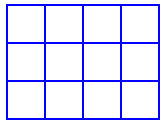Or search by topic
Number and algebra
Geometry and measure
Probability and statistics
Working mathematically
Advanced mathematics
For younger learners
Squares in Rectangles



- Problem
- Getting Started
- Student Solutions
- Teachers' Resources
A $2$ by $3$ rectangle contains $8$ squares:
six small $1\times 1$ squares and two larger $2 \times 2$ squares

A $3$ by $4$ rectangle contains $20$ squares:
twelve $1\times1$ squares, six $2 \times 2$ squares and two $3 \times 3$ squares

Consider rectangles with a height of $2$ units.
Increase their width by $1$ unit at a time.
What effect does this have on the total number of squares?
Make a note of the number of squares in rectangles with a height of $2$ units.
Do you notice anything special?
Use your results to decide whether a rectangle with a height of $2$ units can contain exactly $100$ squares?
What about rectangles with a height of $3, 4, 5, \ldots$?
Draw up a table of results.
Related Collections
You may also like
Square Areas
Can you work out the area of the inner square and give an explanation of how you did it?
2001 Spatial Oddity
With one cut a piece of card 16 cm by 9 cm can be made into two pieces which can be rearranged to form a square 12 cm by 12 cm. Explain how this can be done.

